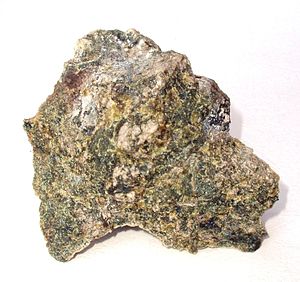Harzburgite
| Igneous rock | |

Harzburgite from a small intrusion 35 km south of Ambositra, Madagascar
|
|
| Composition | |
|---|---|
| Mostly olivine and low-calcium (CA) pyroxene |
Harzburgite, an ultramafic, igneous rock, is a variety of peridotite consisting mostly of the two minerals, olivine and low-calcium (Ca) pyroxene (enstatite); it is named for occurrences in the Harz Mountains of Germany. It commonly contains a few percent chromium-rich spinel as an accessory mineral. Garnet-bearing harzburgite is much less common, found most commonly as xenoliths in kimberlite.
Harzburgite typically forms by the extraction of partial melts from the more pyroxene-rich peridotite called lherzolite. The molten magma extracted from harzburgite may then erupt on the surface as basalt. If partial melting of the harzburgite continues, all of the pyroxene may be extracted from it to form magma, leaving behind the pyroxene-poor peridotite called dunite. Harzburgite may also form by the accumulation of olivine and low-Ca pyroxene in large magma chambers of basalt deep in continental crust (layered intrusions).
Harzburgite is the most commonly found variety of peridotite in ophiolites, which are fragments of oceanic crust and the underlying oceanic mantle obducted and exposed during collision with continental crust. Examples of ophiolites with extensive harzburgite include the Troodos Ophiolite in Cyprus, the Semail Ophiolite in Oman, the Coast Range ophiolites of California, and the Bay of Islands Ophiolite in Newfoundland.
...
Wikipedia
